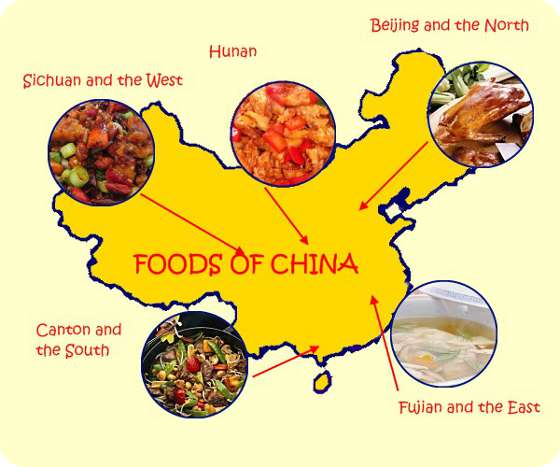Canton and Fukien: the southern cuisine
The provinces of Fukien and Canton make up the southern coast of China, and are the 2 major constituents of the southern Chinese cuisine. As expected, seafood plays an important role due to the geography. The southern Chinese cuisine takes full advantage of the plentiful supply of lobsters, crabs, prawns, shrimps, etc. They are usually stir fried or steamed with ginger, and onion to eliminate the fishy smell. Seafood is also utilized in their seasonings, as oyster sauce, shrimp sauce, and shrimp paste are widely used.
Fukien, which lies northeast of Canton, features beautiful color, and wonderful mixture of sweet, salty, and sour taste in its dishes. "Red distiller's grain" is a famous flavoring often used in Fukien cuisine. It takes over a year to prepare from glutinous rice, fermented with red yeast, and emanates the most interesting aroma of the red yeast.

Of all the Chinese regional cuisines, Canton is perhaps the most familiar and best known to the western cultures. For hundreds of years, Canton has had extensive trade links with the rest of the world, from land, as well as the sea. As such, the art of Cantonese cuisine has long since been taken and spread around the world to represent Chinese cuisine. That, and the fact that the majority of the first group of Chinese emigrants in the 19 th century came from the Canton region, further cemented its influence in the west's interpretation of "Chinese cooking".
The mild, tropical climate in the region produces an abundance of crop all year round. Ample supply of rice, fruit, and vegetables provide plentiful feed for livestock, which in turn, produces high-quality meat and poultry. Along with the wealthy of seafood along the coastline, the south has arguably the most extensive array of dishes in all of China. Having all this assortment of ingredients in their arsenal, the southern chefs pay a great deal of attention to the artistic presentation of the dishes, making them especially appealing to the eyes, as well as the taste buds.
Steaming, boiling, and roasting are popular cooking methods, which preserve the natural flavors and colors of the ingredients. The Cantonese have perfected, and are most renowned for the art of stir frying. Nothing epitomizes the essence of Chinese cooking better than stir frying to achieve food tenderness through quick cooking in order to retain the natural taste, flavor, and color of the ingredients. It is also perfect for those who are health conscious, as these Chinese cooking techniques require the least amount of oil.
Dim sum are little southern delicacies served on small plates or steam baskets for only breakfast or lunch. They are pushed around the restaurants on wheel-carts by the wait staff for the customer to pick from. It is especially popular among bird-lovers in the south. After walking their birds, they would visit Dim sum restaurants, hang the bird cages on a rack, and meet up with friends over tea and rounds of Dim sum to relax and mingle. If you've never tried Dim sum, then you are missing out on quite a unique experience.
This wraps up our brief overview of the major schools of Chinese cuisine. We hope you have enjoyed reading our article series, "The regional cuisines of China ". We have plenty more articles on all facets of Chinese cooking on our website, and we are constantly adding to the database. So bookmark us and visit often. Thanks for reading!
Editor's Note: Helen Fan grew up in a family that has owned various Asian restaurants all over North America, from Vancouver (Canada), Houston (Texas), Decatur (Illinois), to Chicago (Illinois). She, and the rest of the Fan family are now sharing their decades of knowledge on the art of Chinese cuisine at Chinese Home Cooking.
